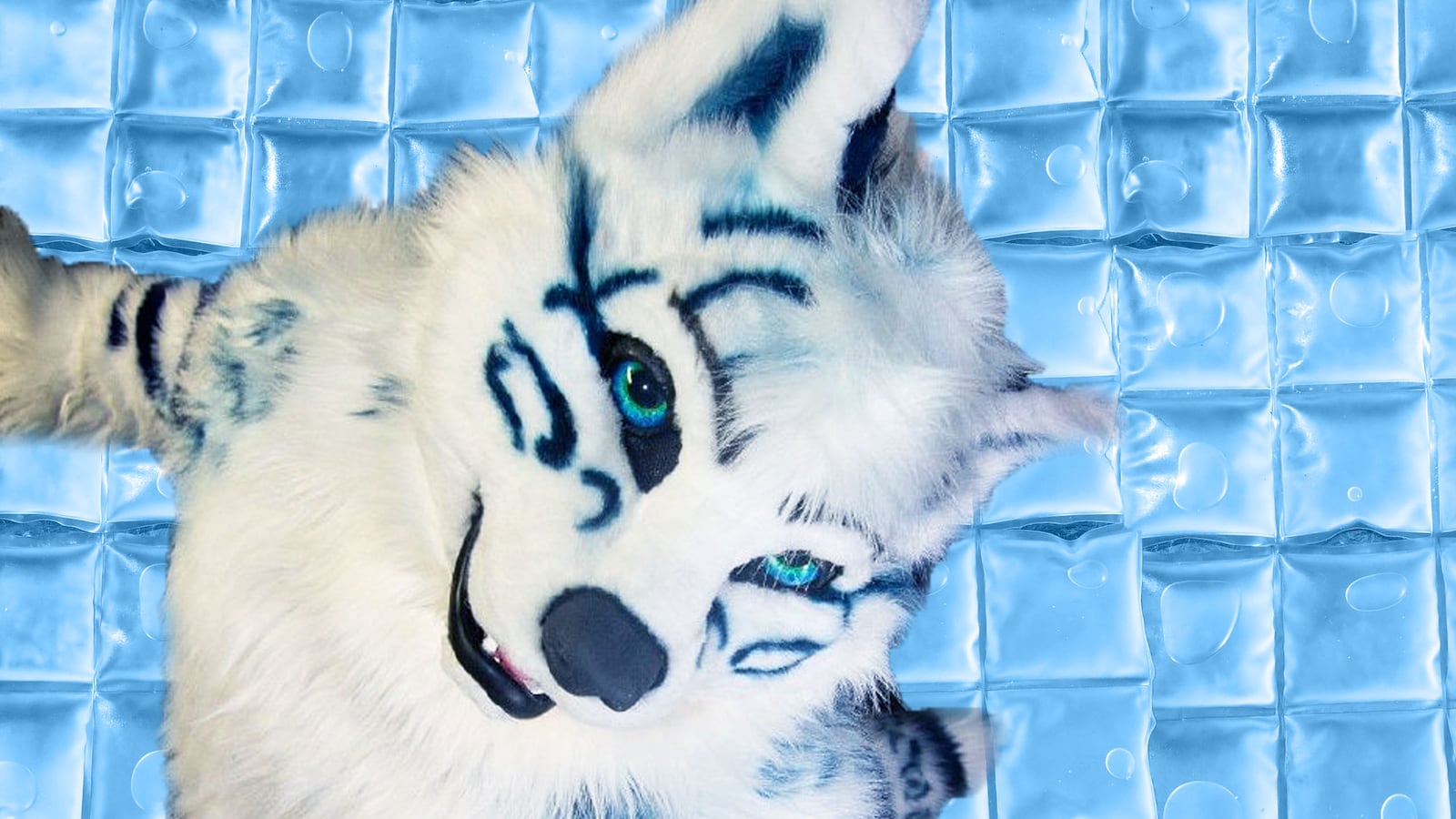Travis finished 14 years of military service clad ears-to-paws in white fur striped with electric blue.
In his green claws, the former armorer for the U.S. Army held a collection of military insignia, including a Combat Action Badge, signifying that he had engaged with enemy fighters in Iraq. He stood before an amused audience of men in tight haircuts and camouflage as his unit came together to honor his service.
In his fursuit, Travis is better known as “Stolf,” a fantastical big cat blending the features of a snow leopard, tiger, and wolf. He likes the odd motorcycle ride or ski run while dressed up, and enjoys meeting other “furries”—members of an internet subculture centered on dressing up as anthropomorphic animals.
In his less colorful uniform, Travis was entrusted with the maintenance and repair of small arms like the Mk 19 grenade launcher, both in Iraq and at his duty station, McChord Air Force Base in Washington state. (Travis asked that only his first name be used because of online threats he’s received.)
The ceremony was a big success. His sergeant had invited him to come in costume since Travis could no longer wear his uniform as a civilian. His unit already knew he was a furry and loved the gag, Travis said. A picture of the proceedings went viral three different times on Twitter.
SWEATY BUSINESS
Playing and performing in a full-body, mascot-like suit is a disciplined endeavor—and not always a comfortable one. Any furry will tell you that it's hot inside a suit and that problem is compounded when members gather in real life. Fursuit-wearers run a real risk of overheating, especially at sunny outdoor events like meetups and Pride parades.
To increase their in-suit endurance, some furries use cooling vests, much like an athlete might. Specially designed vests can hold packs of fluids that remain at steady, low temperatures against wearers’ bodies—a godsend for keeping body heat at bay when you’re wearing fur head to toe.
Whether in body armor or a full body fursuit, Travis, like many of his peers in either camp, often employs one of these cooling layers to avoid overheating. His preferred design: the “EZ Cooldown” vest, crafted by a Dutch furry.
Travis bought his first cooling vest a decade ago and switched to EZ Cooldown in late 2014. “I first used it in uniform under full armor the following summer,” Travis told The Daily Beast. “[It] made a huge difference under the body armor as they raise core temps quite a bit.”
Travis didn’t deploy with his vest or his fursuit, though he did put the vest to the test during training exercises in Washington, donning it for routine tasks like setting up camp and more demanding drills like full-scale simulations of enemy attacks on his unit’s outpost, complete with blank rounds. The vest took the edge off of central Washington’s 80 degree heat and humidity.
While Travis has worn the EZ Cooldown vest more for cosplay than military operations, sometimes those uses overlap, like when he performed in costume for fellow military members at a USO show a few years ago.

Tired of overheating in his own fursuit, Pepeyn Langedijk adapted a military cooling vest to his own ends to create the EZ Cooldown vest. Langedijk, a resident of the Netherlands, goes by “EZ Wolf” in lupine costume and named his invention after his character.
Langedijk and his husband Tom live in Amsterdam and run the EZ Cooldown business together full-time. They met during Elfia, a medieval fantasy reenactment fair, and their hobbies led them to test their product on themselves. The team told The Daily Beast that they sold more than a thousand vests in 2018, which each retail for $215, packs included. Roughly 80 percent of the company’s sales are to U.S. customers.
The pair don’t have official military contracts, but they told The Daily Beast that a small group of U.S. Navy troops in Japan reached out to EZ Cooldown three years ago to ask if the company could ship to military bases. The service members ended up buying 10 vests, then their friends bought 20, then 30, Langedijk said. He still doesn’t know how they heard of his product.
While the Navy did not respond to requests for comment, a spokesperson for the Army explained that soldiers were known to buy cooling vests in an individual capacity.

Langedijk said he first noticed military members using “phase-change cooling vests,” as they’re called, in a CNN segment in 2012. Soldiers primarily wear cooling vests in armored vehicles like tanks that heat up while operating, especially in desert environments, according to a spokesperson for the Army’s equipment department. The Army’s cooling vest system requires its own portable power source, a spokesperson for the branch told The Daily Beast. This kind of vest is bulky, but cools the wearer effectively by circulating chilled fluid through a vest worn against the skin.
As both a cosplayer (an umbrella term for dressing up in costume) and a professional videographer, Langedijk saw the equipment’s potential for extending his time in costume and helping actors stay cool on set, but the military design he had seen was too bulky—heavy, thick around the waist, and “not user-friendly for costumes.”
The Dutch innovator decided to create his own slimmer cooling vest targeted to people in costume, placing cooling packs in the small of the back and high up on the chest to complement the owner’s body. On the way, he worked with partners to concoct a proprietary chemical blend that fills the packs of his vests. He released the product at “Eurofurence,” a furry convention, in 2013. Langedijk’s cosplaying friends quickly told him the design was a “game changer.”
A fursuit maker who spoke with The Daily Beast was familiar with the company’s lightweight design and described its mesh fabric and cooling system as making “a huge difference” over bulkier vests that work through evaporation. The system might be pricier, but the innovation is well worth it, they said.
EZ Cooldown isn’t the biggest vestmaker in the market, but it is the only one run by a furry. According to Langedijk, that community credibility goes a long way.
FURRIES IN UNIFORM
For all their differences, the U.S. armed forces and the furry community do have some overlap. Traces of military furries or “Milfurs” are scattered around the internet for anyone who might go looking. Last year, The Daily Mail profiled a 22-year-old furry named Jordan Jones, a survival equipment manager for the U.S. Navy who dresses up as a purple husky in her spare time and makes custom furry garb for others. Another story profiled the “double life” of Mark Smith, a U.S. Army specialist and furry who runs a YouTube channel called “Mark’s Barks.”
Communities of Milfurs have been coming together online for at least the last decade, reaching out to like-minded souls and sharing difficulties. “I have only met one other [Milfur]... Its a bit difficult to not have anyone else who gets it,” one user wrote. Another asked: “As a lion planning on joining the Air Force, do you think that maned animals will get shaved at basic [training]?” A LiveJournal group, “Military Furries,” hosted a Milfur community for years, but seems to have fallen into disuse.
Fursuiters who spoke to The Daily Beast don’t see a specific reason for the apparent link between the military and their community—furries just come from all walks of life, they say.
“Milfurs are a thing, and some of them live with strict regs and uniforms on duty, and then put on a whole other kind of suit to let loose off duty. Culture and subculture do a dance like that,” said Patch O’Furr, the creator of the furry blog Dogpatch Press. (He asked his legal name not be used to prevent harassment.)
GOING MAINSTREAM
For the Dutch vestmaker, orders from beyond the furry world started coming the same year he debuted his now beloved design. His company now sponsors NASCAR driver Ted Minor and several well-known cosplayers with free vests. Even one Smokey The Bear mascot wears an EZ Cooldown vest, according to Langedijk. (Minor did not immediately respond to a request for comment. An education manager for the USDA Forest Service said individuals do many things to keep comfortable in their suits but that the agency makes no official endorsements or recommendations.)
Langedijk told The Daily Beast that roofers, miners, offshore drillers, surgeons, video game testers, pet owners, and sports league mascots have all written to say they love the vest in their specific contexts.
“We can’t even imagine all the applications for the vest,” Langedijk said. “The level of creativity with these is quite impressive.”
Langedijk predicts his business will only get bigger, but not because furries are becoming more mainstream. He’s counting on more global factors.
“People who live in moderate climate areas like Scandinavia are most interested in the vest. It’s the second year in a row that we’re having awful heat waves here in Europe,” he said. “Climate change is happening.”
Furry blogger Patch O’Furr told The Daily Beast that he is continually impressed by the “buffet of skills” he watches emerge from the grassroots furry community. He sees the innovative cooling vest that found its way onto the backs of U.S. service members as just one example among many.
“I have to say I love knowing about what EZ Wolf made,” he told The Daily Beast. “I know he's not just a product seller or a single talent, he's one of those secret weapons of furry subculture.”






